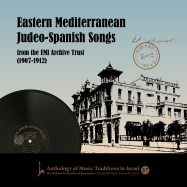(366 results found)
36. La bella en misa (CES)
… is reduced here to a partial description of her beauty with similes from nature. Her head is compared to a … … 10 … 7 … 40855 … Eastern Mediterranean Judeo-Spanish Songs from the EMI Archive Trust (1907-1912) … Ladino, Ladino - Judeo-Espagnol - Judizmo, Ladino Songs, Ladino - Judeo-Espanol - Judizmo, Ladino - …
35. Toma mi alma y tómala (CES)
… A rare cluster of stanzas with a well-known refrain. The closest version to this love song was documented by Bassan ( 1947 , no. 55), also from Salonica. It appears that this song is related to Partiendo de Salonik performed by Jako …
32. La agonía del amante Rosa mia (CES)
… The opening of this song, “Conğa mía conğa mía / chichek de mi cabeza” (“conğa” means “rosebud” in Turkish; the name of the song on the record label is “Rosa mia”) is a formulaic … in a musical transcription by Idelsohn ( 1923 , no. 484) with the same opening stanza. This transcription is very …
31. El lindo mancebo + Los amantes de la casa rica Oh! que lindo mancevo (CES)
… modern recorded repertoire and are usually sung together with other stanzas entitled Los amantes de la casa rica ( … between them. Attias cites his mother’s testimony that the song refers to an actual love affair between a poor girl and … … 10 … 7 … 40847 … Eastern Mediterranean Judeo-Spanish Songs from the EMI Archive Trust (1907-1912) … Ladino, …
27. El alma dolorida (CES)
… A song from the beginning of the twentieth century, it was … , no. 142). Most probably, this is a case of two different songs pasted together (stanzas 1-5, two decasyllabic lines … during the piece as prelude, interlude and postlude, with stanza 6 sung to its melody. This last stanza contrasts …
26. La rosa de mayo + Los bilbilicos (CES)
… into one unit became one of the quintessential Sephardic songs in the twentieth century commercial market (see Attias … Effendi ( 2008 , CD III, no. 17) recorded a similar version with an additional fourth stanza. The melody was adapted at an early stage to religious Hebrew texts, especially to the Sabbath table song, Tzur …
24. El buceador (CES)
… that was well known in Salonica, but the rest of the song is totally different. Attias ( 1972 , no. 5) has documented this song with the opening “Se pasea Katina.” However, the …
19. El guitarrista + La firmeza de las estrellas + El enamorado engañado (CES)
… to the late-nineteenth century flamenco repertoire. The song was also recorded by Albert Beressi (Odeon 54339, 1907/8) and Haim Effendi (CD IV, no. 7, 1913) (with slightly different texts), an evidence of its … 1972 , nos. 1 and 3). Although appearing under the CES, the song is performed by a soloist and his performance is very …
18. La hermosa durmiente (CES)
… This is one of the most popular Ladino songs both historically and up to the present, first … recording, unlike most of the documented versions, starts with a rare stanza and not with the widespread one: “Durme … that led many modern performers to categorize this song as a lullaby. This rare stanza was to date found only …
16. El pájaro de amor (CES)
… Hemsi 1995 , no. 86). Commonly the opening stanza of this song is “Mama yo no tengo visto / pájaro con ojos mavís,” a … this recording is close to Hemsi’s main version (no. 86A), with a different order of stanzas. Most notably, the fourth … logically located in Hemsi’s version at the opening of the song. The melody is very similar to the one registered for …



